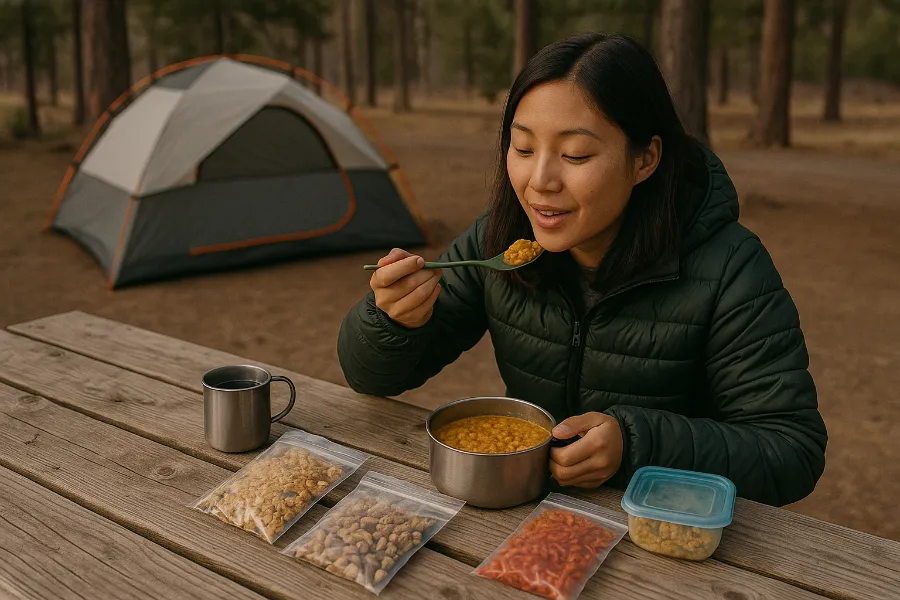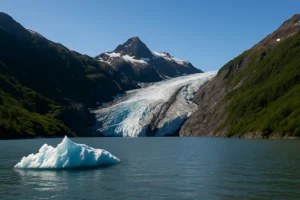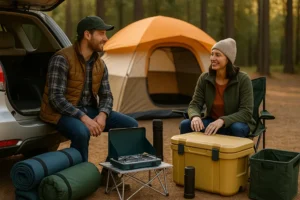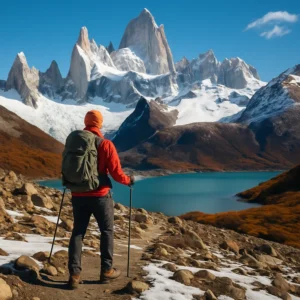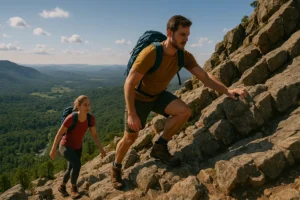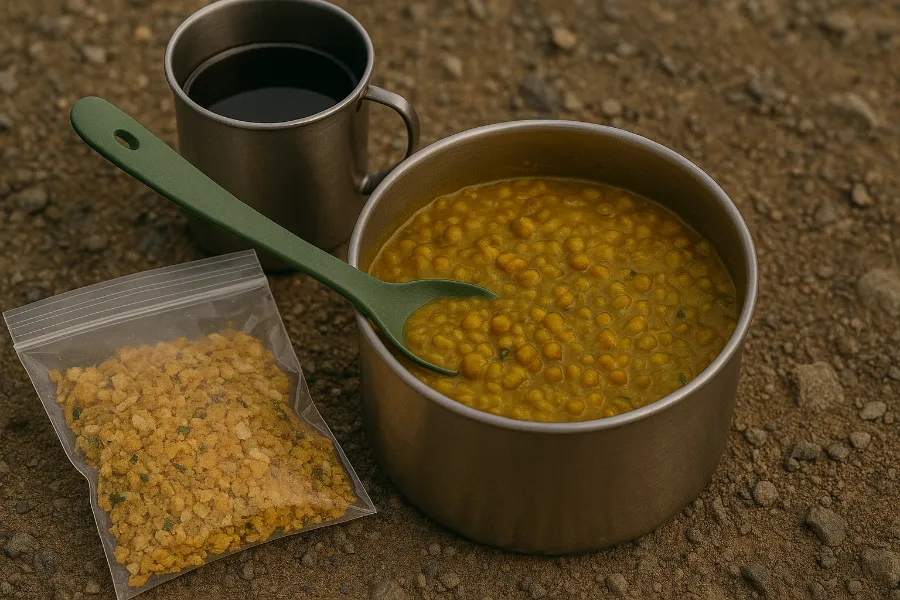
Backpacking is about pushing your limits, soaking in wild landscapes, and finding freedom in the simplicity of life outdoors. But there’s one thing that can make or break your trip: food. And if you’re plant-based, figuring out the right vegan backpacking food can feel tricky at first. The good news? With a little planning, it’s easier than ever to eat well, stay energized, and enjoy every meal on the trail.
In this guide, we’ll cover everything you need to know about vegan backpacking food—from meal planning and nutrition to packing strategies, resupply tips, and trail-tested recipes. Whether you’re heading out for a weekend hike or a multi-week thru-hike, this is your go-to resource.
Things to Consider When Choosing Vegan Backpacking Food
Nutrition
When you’re burning thousands of calories a day, every bite counts. Focus on foods that are calorie-dense yet lightweight. Aim to balance:
- Carbohydrates for sustained energy (oats, rice, couscous, pasta)
- Proteins for muscle repair and recovery (lentils, beans, tofu, tempeh, protein powders)
- Healthy fats for long-lasting fuel (nuts, seeds, oils, nut butters)
- Micronutrients like iron, calcium, and vitamin B12 (nutritional yeast, fortified plant powders, leafy greens when available)
Weight and Packability
A light pack makes for a happy hiker. Choose foods that are lightweight, dehydrated, or compact. Avoid glass jars, canned goods, and bulky packaging. Resealable bags and powdered alternatives can help cut down on weight.
Convenience
On the trail, you don’t want to spend hours cooking. Opt for meals that are quick and simple. Pre-soak oats, choose instant couscous, or bring dehydrated meals that cook in minutes.
Climate and Weather
Weather affects appetite and storage. In hot climates, avoid foods that spoil easily. In colder conditions, pack extra calories and warming meals like stews and curries.
Resupply Options
If you’re thru-hiking, research towns along your route. Many grocery stores now stock vegan options, but in smaller towns, you may rely on “accidentally vegan” snacks (Oreos, chips, tortillas) or pre-mailed resupply boxes.
Core Vegan Backpacking Meals
Breakfast
Start strong with a mix of complex carbs and protein:
- Oats or porridge with dried fruit, seeds, and nut butter
- Granola with powdered plant milk
- Breakfast wraps with banana, peanut butter, or jam
- Tofu scramble with nutritional yeast, onion powder, and spices
- Vegan pancake mixes (just add water)
Lunch
Keep it light, quick, and easy to eat on the move:
- Tortilla wraps with hummus, nut butter, or tahini
- Trail mix, dried fruit, and seeds
- Mushroom or soy jerky
- Dehydrated hummus or bean dips
- Patagonia Provisions soups or instant noodles
Dinner
Evenings call for hearty meals that restore your energy:
- Freeze-dried vegan meals from brands like Good To-Go, Backpacker’s Pantry, or Firepot
- DIY dehydrated meals (lentil curry, chili, pasta)
- Instant ramen upgraded with dried veggies, miso paste, and seaweed
- Quinoa or couscous bowls with beans, spices, and olive oil
Snacks and Energy Boosters
Snacks keep you moving between meals. Aim for a mix of sweet and savory:
- Energy bars (Clif, ProBar, Bobo’s, or homemade)
- Energy balls made with dates, oats, and nut butter
- Flapjacks or banana bread
- Roasted chickpeas or spiced lentil patties
- Dried fruit, nuts, and seeds
- Vegan cookies for a morale boost
Meal Planning and Caloric Needs
Backpacking burns serious calories. Most hikers need between 3,000–4,500 calories per day depending on mileage, terrain, and body size. A sample schedule might look like this:
- 7:30 am – Oats with nut butter and coffee
- Midday – Wrap with tahini + trail mix
- 4:00 pm – Energy bar and dried fruit
- 6:00 pm – Hearty dinner like lentil curry with rice
- Throughout the day – Snacks like nuts, seeds, and electrolyte drinks
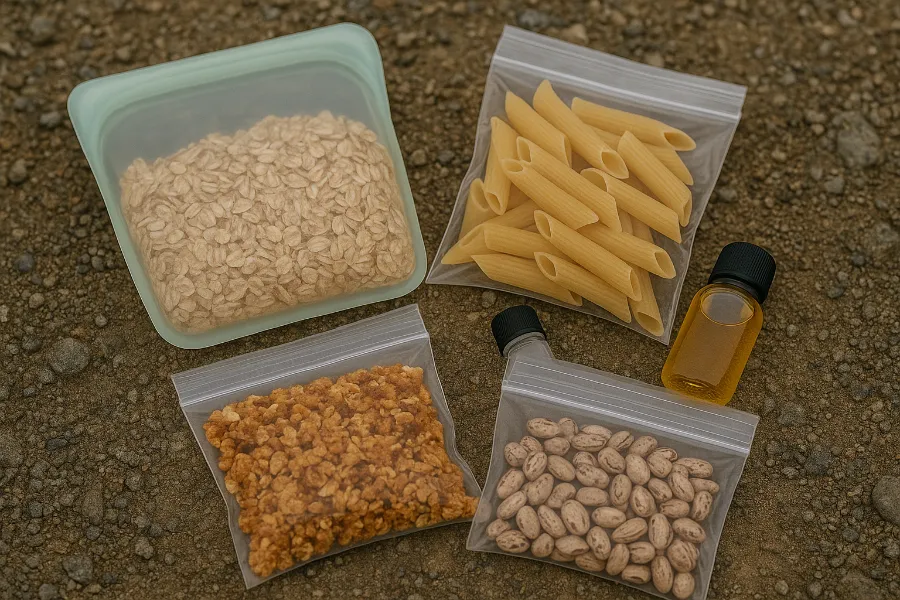
Food Storage and Packing Tips
- Use ziplock bags or reusable silicone pouches to ration daily meals
- Repackage store-bought foods to cut down weight and trash
- Carry oil in leak-proof bottles for calorie boosts
- Always store food properly overnight—bear canisters or bags are essential in some areas
Enhancing Meals on the Trail
Trail food doesn’t have to be bland. Boost flavor and nutrition with:
- Nutritional yeast (cheesy flavor + B12)
- Miso paste (savory, nutrient-packed)
- Garlic and onion powder
- Chili flakes, curry powder, or DIY spice mixes
- Dried seaweed for minerals and flavor
Resupply Strategies
If you’re on a long trek:
- Plan ahead with resupply boxes of dehydrated meals and snacks
- Stock up in towns on oats, tortillas, nut butters, chips, dried fruit, and “accidentally vegan” foods
- Look for health food stores when available for plant-based specialty items
Gear Essentials for Cooking & Eating
You don’t need a full kitchen to eat well outdoors. Essentials include:
- Lightweight stove and fuel
- Pot or cookset
- Spork or utensils
- Mug for hot drinks
- Ziplock bags or Tupperware for leftovers
- Optional: a dehydrator at home for prepping meals

Sample Trail-Friendly Recipes
Energy Balls
Mix oats, dates, nut butter, and cocoa powder. Roll into bite-sized balls. Perfect for snacking on the go.
Vegan Lentil Curry (Dehydrated)
At home: Cook lentils with onion, garlic, curry powder, and coconut milk. Dehydrate into portions. On trail: Rehydrate with boiling water for a warm dinner.
Breakfast Wrap
Spread peanut butter and jam on a tortilla, add a sliced banana, and sprinkle with seeds. Quick, filling, and delicious.
Miso Ramen Upgrade
Take instant ramen noodles, add a spoonful of miso paste, dried seaweed, and dehydrated mushrooms. A nutrient-packed comfort meal.
Parting Advice
Eating vegan on the trail is absolutely possible, and with the right planning, it’s enjoyable, energizing, and even exciting. Pack calorie-dense staples, add flavor with spices and condiments, and embrace creativity when resupplying. Most importantly, listen to your body, fuel it well, and let your meals enhance—not hinder—your adventure.
Backpacking is about freedom and connection, and your food should support that. With this guide, your vegan backpacking food is sorted—you just need to hit the trail and start exploring.

